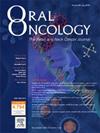转移性头颈部癌原发肿瘤的治疗:一项系统回顾和荟萃分析
IF 4
2区 医学
Q1 DENTISTRY, ORAL SURGERY & MEDICINE
引用次数: 0
摘要
头颈部转移性鳞状细胞癌(HNSCC)原发肿瘤的治疗是一个复杂而有争议的问题。本研究通过系统回顾和荟萃分析评估原发肿瘤治疗对转移性HNSCC总生存期(OS)和无进展生存期(PFS)的影响,重点是确定现有证据中的潜在偏差和局限性。材料与方法在PubMed、EMBASE和Cochrane Library中进行了全面的文献检索,检索截止到2024年1月发表的研究。研究比较了单独的全身治疗与针对原发肿瘤的全身治疗联合局部治疗,不论有无颈部淋巴结。符合条件的研究报告了IV期HNSCC或鼻咽癌的OS或PFS结果。使用随机效应模型计算合并风险比(hr)和95%置信区间(ci),以解释研究的异质性。荟萃分析包括48项研究,33,637例患者。治疗原发肿瘤可显著改善OS (HR = 0.55;95% ci, 0.49-0.61;P & lt;0.01)和PFS (HR = 0.57;95% ci, 0.35-0.95;P = 0.03)。然而,观察到显著的异质性(I2 = 86%),反映了患者群体、治疗方案和研究设计的可变性。结论:该荟萃分析表明,治疗转移性HNSCC的原发肿瘤可能与改善生存结果相关。然而,由于存在显著的局限性,包括高度异质性、潜在偏倚和回顾性研究的优势,这些发现必须谨慎解释。本文章由计算机程序翻译,如有差异,请以英文原文为准。
Treatment of primary tumor in metastatic head and neck Carcinoma: A systematic review and Meta-Analysis
Introduction
The treatment of primary tumors in metastatic squamous cell carcinoma of the head and neck (HNSCC) is a complex and debated issue. This study evaluates the impact of treating primary tumors on overall survival (OS) and progression-free survival (PFS) in metastatic HNSCC through a systematic review and meta-analysis, with a focus on identifying potential biases and limitations in the available evidence.
Materials and Methods
A comprehensive literature search was conducted in PubMed, EMBASE, and The Cochrane Library for studies published up to January 2024. Studies comparing systemic therapy alone to systemic therapy combined with locoregional therapy targeting the primary tumor, with or without neck nodes, were included. Eligible studies reported OS or PFS outcomes in stage IV HNSCC or nasopharyngeal cancers. Pooled hazard ratios (HRs) and 95% confidence intervals (CIs) were calculated using random-effects models to account for study heterogeneity.
Results
The meta-analysis included 48 studies comprising 33,637 patients. Treating the primary tumor significantly improved OS (HR = 0.55; 95 % CI, 0.49–0.61; P < 0.01) and PFS (HR = 0.57; 95 % CI, 0.35–0.95; P = 0.03). However, significant heterogeneity was observed (I2 = 86 %), reflecting variability in patient populations, treatment protocols, and study designs.
Conclusions
This meta-analysis suggests that treating the primary tumor in metastatic HNSCC may be associated with improved survival outcomes. However, these findings must be interpreted with caution due to significant limitations, including high heterogeneity, potential biases, and the predominance of retrospective studies.
求助全文
通过发布文献求助,成功后即可免费获取论文全文。
去求助
来源期刊

Oral oncology
医学-牙科与口腔外科
CiteScore
8.70
自引率
10.40%
发文量
505
审稿时长
20 days
期刊介绍:
Oral Oncology is an international interdisciplinary journal which publishes high quality original research, clinical trials and review articles, editorials, and commentaries relating to the etiopathogenesis, epidemiology, prevention, clinical features, diagnosis, treatment and management of patients with neoplasms in the head and neck.
Oral Oncology is of interest to head and neck surgeons, radiation and medical oncologists, maxillo-facial surgeons, oto-rhino-laryngologists, plastic surgeons, pathologists, scientists, oral medical specialists, special care dentists, dental care professionals, general dental practitioners, public health physicians, palliative care physicians, nurses, radiologists, radiographers, dieticians, occupational therapists, speech and language therapists, nutritionists, clinical and health psychologists and counselors, professionals in end of life care, as well as others interested in these fields.
 求助内容:
求助内容: 应助结果提醒方式:
应助结果提醒方式:


